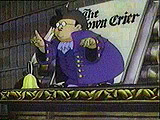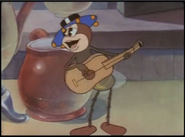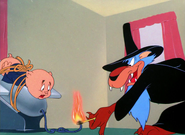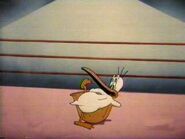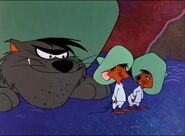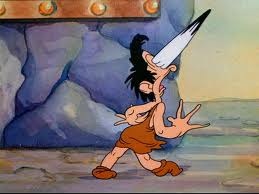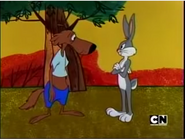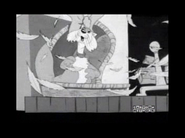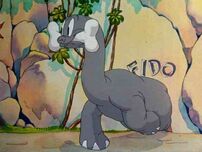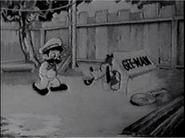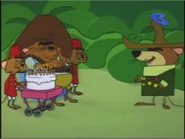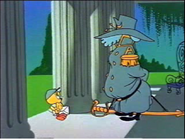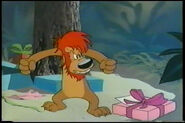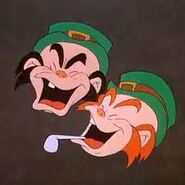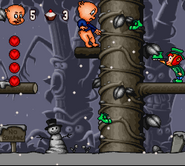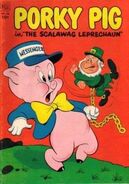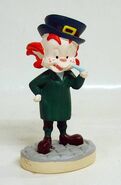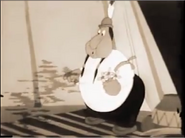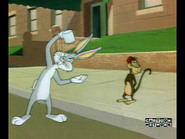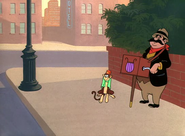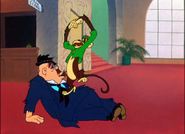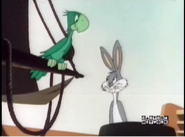#
The Three Stooges
The Three Stooges are three humans than seem to parody the actual Three Stooges. They appeared in The Girl at the Ironing Board, Buddy's Lost World, Porky in Wackyland, and Hollywood Steps Out.
A
A. Flea
A. Flea is a hungry flea yokel.
- Main article: A. Flea
Ape Waiter
An ape waiter that serves booze (beer) to customers in the following shorts: Lady, Play Your Mandolin! and Goopy Geer.
Aunt Jemima
An advertising character for a syrup company, this woman appeared in September in the Rain and Tin Pan Alley Cats. Some sources say she appeared in The Looney Tunes Show (Episode 12: Double Date), but this is unconfirmed.
Unnamed Alley Cat
A black cat who has appeared in the following shorts: Angel Puss, It's Hummer Time, Early to Bet and A Fractured Leghorn.
Adolf Hitler
- Main article: Adolf Hitler
Ali Baba and His Men
Arabians that Porky is sent to capture in the short Ali-Baba Bound.
Ala Bahma
- Main article: Ala Bahma
Alexander Woolcott Impersonator
An impersonator of Alexander Woolcott, he is an owl in disguise. His only appearances were in The Woods Are Full of Cuckoos and Have You Got Any Castles?.
Alice
A woman who appears in the Merrie Melodies short, Three's a Crowd.
African Natives
Natives who appeared as Blackface Caricature s in the following shorts: Buddy of the Apes, Speaking of the Weather, Jungle Jitters, The Isle of Pingo Pongo and Africa Squeaks.
Al The Bird
A parrot who appeared in Curtain Razor.
Asian Tweety
A Chinese accented bird who appears in Tweety and the Beanstalk and bears a resemblance to Aooga.
Alien Invaders
Alien Invaders are Men From Mars. In Kitty Kornered, the Alien Invaders are secretly pussycats in disguise trying to torment Porky out of his home.
Air Force Ants
Ants who work as an army/air force to defeat their enemies. They have appeared in Target Snafu, Of Thee I Sting, and Ant Pasted.
Adolph Kitler
Adolph Kitler is a cat that is a parody of Hitler. His only appearance is in The Fifth-Column Mouse.
Alligators
Animal predators who attempt to eat up their pray. They were seen in A Cartoonist's Nightmare, Hare-Abian Nights, and Water, Water Every Hare.
Angus MacRory
- Main article: Angus MacRory
Angel Packed Cats
Angel cats who have appeared in 3 shorts: Angel Puss, Back Alley Oproar, and Notes to You.
Ant
An unnamed ant character is seen in the short, Foney Fables. He is small in height.
The Angry Fish
An angry fish appears in the following shorts: Pagan Moon, Bosko at the Zoo, A Day at the Zoo, A Star is Bored, and Sandy Claws.
B
Babbit and Catstello
- Main article: Babbit and Catstello
Babbit and Catstello are cats based on the comedic duo Abbott and Costello. Although the short, fat character calls the other one "Babbit", the tall, skinny one never addresses his partner by name; the name "Catstello" was invented later. In their first three cartoons, the "Babbit" character was voiced by Tedd Pierce, and Mel Blanc performed "Catstello".
Originally, the pair were cats in pursuit of a small bird for their meal in the 1942 Bob Clampett-directed cartoon A Tale of Two Kitties, a cartoon notable for the first appearance of the bird character, who would eventually become Warner Bros. cartoon icon Tweety Bird. The hapless duo fail in every attempt to capture the bird, establishing the pattern that would be used time and again in future Tweety cartoons.
Three years later, Babbit and Catstello reappeared in the similarly named Tale of Two Mice, directed by Frank Tashlin. Though their characterizations were the same, the two were now mice, living in a hole in the wall of a typical cartoon kitchen. Their goal in this cartoon was the cheese in the kitchen's refrigerator, the only obstacle being the resident housecat. Babbit attempts to coerce Catstello (often by beating him up) into going after the cheese solo, using various methods to get it (which involved Catstello getting hurt). However, in the end, it is Swiss cheese, which Babbit can't stand. Angrily, Catstello beats him up and begins force-feeding the cheese, uttering one of his archetype Lou Costello's famous lines: "Oh — I'm a baaaaad boy!" (At one point in A Tale of Two Kitties, he similarly =1946. They play the pets of the real Abbott and Costello, Costello's dog, refers to Abbott's dog as 'Babbit'.
Finally, six months later in October 1946, Robert McKimson returned to the pair in The Mouse-Merized Cat, wherein Babbit uses a book to hypnotize Catstello. Babbit has Catstello believe he's a dog in order to scare off the cat so they can get to the food in the refrigerator. However, the cat soon studies hypnosis and is able to reverse Babbit's spell. This results in Catstello running back and forth between the two as they continue use hypnosis. Finally, Catstello becomes fed up with Babbit making him the fall guy, and turns the tables on both Babbit and the cat, hypnotizing them into believing they are, respectively, a cowboy and his trusty steed. Catstello trickes Babbit with his Yosemite Sam like voice makes Babbit utter a deliberately misworded variation on the Lone Ranger's classic catchphrase — "Hi yo, Sliver, awaaayy!" — before he and the cat gallop away. The final scene shows Catstello eating cheese and reading a book on living alone, before turning to the audience and once again reciting "Oh — I'm a baaaaadd boy!"
The pair have made few appearances since then, mainly cameos in modern Warner Bros. animated projects such as The Sylvester and Tweety Mysteries voiced by Jim Cummings and Joe Alaskey.
Bad Female Moth
The Bad Female Moth is an antagonist that has appeared in Eatin' on the Cuff or, The Moth Who Came to Dinner and Bingo Crosbyana, where she was captured by Bingo.
Barnyard Dawg
Barnyard Dawg is the dog antagonist of Foghorn Leghorn.
- Main article: Barnyard Dawg
Beans the Cat
- Main article: Beans
Benny
A fat cat who appears in Lighthouse Mouse and Cat-Tails For Two.
Biff Stew
Biff Stew is a wrestler, who is also Egghead's enemy in the short Count Me Out.
Bill Weasel
Bill Weasel was a small, gnash-happy weasel with the hyperness of the Tasmanian Devil. He craved chicken and was always after Foghorn Leghorn. He appeared in "Weasel Stop," "Plop Goes the Weasel," and "Weasel While You Work."
Bingo Crosbyana
Bingo Crosbyana is a bug parody of famous singer Bing Crosby. His only appearance to date was in the 1936 short Bingo Crosbyana.
Black and White Cat
A nameless male black and white cat who appears in the shorts Paying the Piper (1949), Swallow the Leader (1949), It's Hummer Time (1950), A Fractured Leghorn (1950), Early to Bet (1951) and Leghorn Swoggled (1951). He is voiced by Mel Blanc. In the third and fifth, the cat is antagonized by an unnamed bulldog who gives him either humiliating or also painful sentences for bugging him in the second cartoon and for losing bets in the fourth short. This may also be the same poor cat that appears in Fresh Airedale, about a dog (Shep) that keeps taking credit for the good deeds of a cat and placing blame on the cat.
Black Panther
Black Panther is a minor character who only appears in the short Tree for Two.
Blackface Ant
An ant imitating blackface in the short Porky's Midnight Matinee.
Blacque Jacque Shellacque
Blacque Jacque Shellacque was created by Robert McKimson. While similar in many ways to Yosemite Sam—both are short in stature and temper—Blacque Jacque possesses his own unique characteristics, not the least of which is his comically thick French Canadian accent, performed by Mel Blanc. Also, like Yosemite Sam and many other villains, Blacque Jacque Shellacque does not have a high level of intelligence, preferring to use force instead of strategy to fight Bugs.
Blacque Jacque first appeared in Bonanza Bunny, which takes place in the middle of the Klondike gold rush. Blacque Jacque attempts to seize Bugs' bag of gold (actually "a bunch of rocks and some yellow paint," according to Bugs) through card cheating, trickery, and out-and-out threats, but Bugs outwits him as always and defeats him by replacing his bag of gold with gunpowder while poking a hole in the bag and tossing a lit match on it causing a massive explosion.
Blacque Jacque later clashed with Bugs in 1962's Wet Hare, in which his illegal damming of a river ("Me feel like pezky little beav-aire!") brings him into conflict with the rabbit—not only because he is committing a crime, but because he has blocked off the waterfall that Bugs uses as a shower. After demolishing several of Blacque Jacque's dams, Bugs turns the tables by damming the river upstream of Jacque's dam. Jacque, unsurprisingly, is enraged and wheels a small cannon along the riverbed to destroy Bugs' dam—but when he does he only reveals another dam further upstream. Jacque blows up several of Bugs' dams in succession and finally follows Bugs all the way to the "Grand Cooler Dam" (a pun on the name of the Grand Coulee Dam). Jacque tries to blow it up with his cannon, but the dam is so massive and thick that the cannonball he launches ricochets back into the cannon's barrel and the recoiling force lands both Jacque and the cannon into the back of a waiting paddy wagon.
Blacque Jacque also appears as a common enemy in Bugs Bunny: Lost in Time.
Bluebeard
Bluebeard is a villain who only appeared in the short Bye, Bye Bluebeard.
Bobo the Elephant
Bobo is a baseball mascot.
- Main article: Bobo The Elephant
Bookworm
Bookworm is a character in the Warner Bros. Looney Tunes shorts. Bookworm made his first appearance in "Sniffles & The BookWorm." Since then, he has appeared in some recent Warner Bros. projects such as 1996's film Space Jam.
The Body
- Main article: The Body''
Bosko
- Main article: Bosko
Unnamed Boxer
An unnamed Boxer appears in the short Porky & Daffy.
Unnamed Boxer Host
A pelican who hosts the boxing match in the short, Porky & Daffy.
Bruno
Bruno is Bosko's dog.
- Main article: Bruno
Brownie
Brownie mouse has appeared as an enemy and prey of Sylvester in some Looney Tunes shorts. Some of his appearances include Mouse Mazurka, Little Red Rodent Hood, Canned Feud, The Unexpected Pest, Greedy For Tweety, and A Mouse Divided. He also appeared in the Bugs Bunny cartoon Rhapsody Rabbit as Bugs' antagonist.
Buddy
- Main article: Buddy
Unnamed Bully
A cat who torments Beans in a skiing competition in the short Alpine Antics.
Businessman
- Main article: Businessman
Bunny and Claude
- Main article: Bunny and Claude
Bunny and Claude are robbers (based on the real-life Bonnie and Clyde and the then recent film version) that had been released by Warner Bros. They are a well-dressed rabbit male (Claude) and female (Bunny) duo who are always pulling off carrot heists, and their catch phrase is "We rob carrot patches", based on the film Bonnie and Clyde "We rob banks."
Bunny was voiced by Pat Woodell and Claude was voiced by veteran WB voice actor Mel Blanc. They both speak with pronounced Southern accents.
They appeared in two cartoons produced by Warner Bros. Animation and released by Warner Bros.- Seven Arts in 1968, titled Bunny and Claude: We Rob Carrot Patches and The Great Carrot Train Robbery (the latter was held over to 1969). Both films were directed by Robert McKimson, and were his first two cartoons he directed in his comeback to Termite Terrace.
Bunny and Claude were always chased by a stereotypical Southern sheriff (also voiced by Mel Blanc, his voice sounding similar to Foghorn Leghorn and Yosemite Sam), who would always pursue them in his police cruiser even though the gangster rabbits would always foil his plans.
Bugs Bunny
- Main article: Bugs Bunny
Honey Bunny
Honey Bunny is one of Bugs' girlfriends.
- Main article: Honey Bunny
Lola Bunny
- Main article: Lola Bunny
Beaky Buzzard and Mama Buzzard
- Main article: Beaky Buzzard
- Main article: Mama Buzzard
C
Canyon Kiddies
The Canyon Kiddies are a group of kids in the Looney Tunes and Merrie Melodies series of theatrical shorts. They appeared in very few shorts, the first being The Mighty Hunters. The Canyon Kiddies never became very popular characters, but did appeared in the 1996 film Space Jam.
Cat #1
A cat who's job is to torment Speedy Gonzales in the short, Tabasco Road.
Casper Caveman
A caveman who is a parody of comedian Jack Benny. His only appearance to date was in the short Daffy Duck and the Dinosaur.
Cecil Turtle
- Main article: Cecil Turtle
Charlie Dog
- Main article: Charlie Dog
Charlie Dog, Charlie the Dog or Charles the Dog is a brown dog. Bob Clampett minted the scenario that Charlie Dog would later inherit in his cartoon short Porky's Pooch, first released on 27 December 1941. A homeless hound pulls out all the stops to get adopted by bachelor Porky Pig. Mel Blanc would provide the dog's gruff, Brooklyn-Bugs Bunny-like voice and accent which became Charlie's standard voice.
However, as he did for so many other Looney Tunes characters, Chuck Jones took Clampett's hound and transformed him into something new. Jones first used the dog in Little Orphan Airedale (4 October 1947) which saw Clampett's "Rover" renamed "Charlie." The film was a success, and Jones would create two more Charlie Dog/Porky Pig cartoons in 1949: Awful Orphan (29 January) and Often an Orphan (13 August). Jones also starred Charlie without Porky in a couple of shorts: Dog Gone South (26 August 1950) which sees Yankee Charlie searching for a fine gentleman of the Southern United States, and A Hound for Trouble (28 April 1951) which sends Charlie to Italy where he searches for a master who speaks English.
In these cartoons, Charlie Dog is defined by one desire: to find himself a master. To this end, Charlie is willing to pull out all the stops, from pulling "the big soulful eyes routine" to boasting of his pedigree ("Fifty percent Collie! Fifty percent setter, Irish Setter! Fifty Percent Boxer! Fifty percent Doberman Pincher! Fifty percent pointer—there it is! There it is! There it is! But, mostly, I'm all Labrador Retriever!") when reminded by others that he is not a Labrador retriever, his response would be, "If you'll find me a Labrador, I'll retrieve it for you." —though in reality, he is just a slick-talking mutt who rarely realizes that his own aggressive obnoxiousness is sabotaging his appeal to any potential guardian.
Charlie makes a brief cameo appearance (via re-used animation from Often an Orphan) in the Robert McKimson-directed short Dog Tales (1958). Jones shelved the Charlie Dog series of films in the 1950s, along with other characters he had introduced, such as The Three Bears and Hubie and Bertie. He was turning his efforts to new characters, such as Pepé Le Pew and Wile E. Coyote and The Road Runner. However, recent Warner Bros. merchandising and series and films such as episodes of Tiny Toon Adventures, the film Space Jam (1996) in the crowd scenes (here performed by Frank Welker), and Tweety's High-Flying Adventure (2000) in Italy have brought Charlie back out of retirement.
The Frisky Puppy character that Jones paired with Claude Cat in several '50s shorts bears a close physical resemblance to Charlie.
Charlie Dog made a cameo appearance in The Looney Tunes Show episode "Father Figures". He is seen at a pet store where he was attacked by Henery Hawk (who was looking for a chicken).
Charles M. Wolf
Charles M. Wolf (also known as The Big Bad Wolf or as his wife calls him, Charlie) is a dimwitted wolf who appeared in Red Riding Hoodwinked (1955) and Hare-Less Wolf (1958).
His name is only given in the second feature and apparently spoofs animator Chuck Jones, whose real name was Charles Martin Jones. In his first appearance, his design resembled a modified version of Sylvester. But in his later appearance, his design was greatly simplified to make it look aardvark-like
Claude Cat
Claude Cat (a pun on the homophone "clawed cat") had his origins in several other cat characters used by Chuck Jones from 1940 to 1945. These cats were mostly similar in appearance and temperament, with black fur and anxious personalities. For example, in the 1943 film The Aristo-cat (the character's first speaking role), Jones paired his unnamed cat against the mind-manipulating mouse duo, Hubie and Bertie.
Jones redesigned the neurotic feline for the 1948 film Mouse Wreckers (perhaps to distinguish him from Friz Freleng's popular puss, Sylvester). The short is another Hubie and Bertie vehicle, only this time, the antagonist they antagonize is Claude, drawn as he would appear in all future cartoons: yellow, with a red shock of hair and a white belly (his exact markings would vary from cartoon to cartoon). In this as in all future Claude Cat cartoons, Jones' careful attention to personality is easily evident. Claude is a nervous and lazy animal. His attempts to protect his home from the manipulative mice Hubie and Bertie prove futile as the rodents torment him by (among other things) putting aquariums in all the windows to make Claude think he's underwater or by nailing his furniture to the ceiling. Jones set the mice on Claude once more in the 1950 film The Hypo-Chondri-Cat. This time, the miniature Machiavellis convince the neurotic Claude that he's dead. Claude would run afoul of the mice once more in 1951's Cheese Chasers and against another mouse duo in Mouse Warming in 1952.
Jones added another idiosyncrasy to Claude's id in another 1950 film, Two's a Crowd. Here, Claude is scared out of his mind by a diminutive dog named Frisky Puppy, newly adopted by Claude's owners. The main theme, however, is jealousy as Claude's attempts to oust the intruder repeatedly fail due to the cat's intense cowardice - a running gag has Claude repeatedly shooting up and clinging to the ceiling after the pup playfully comes up behind him and barks. in a form of a series of loud yelps, in a high register. At the end, however Claude gets revenge by pulling the same trick causing the dog to comically leap up and cling to the ceiling. Jones repeated the scenario with slight variations in Terrier Stricken in 1952 and No Barking in 1954 (the latter featuring a cameo by Tweety Bird).
In future cartoons, Jones recast Claude as a silent villain, still possessing his full set of neuroses. This stage of the character's evolution is best exemplified by the 1954 film Feline Frame-Up. Here, Claude convinces his owner that fellow pet Marc Antony is trying to eat the precious kitten Pussyfoot. Marc Antony is tossed out, allowing Claude the run of the house. That is, until Marc Antony outwits the cat and makes him sign a confession admitting to his crimes.
Claude was played by voice actor Mel Blanc and after classic films, Joe Alaskey using a quirky, strangulated voice similar to that of Marvin the Martian (but without Marvin's precise enunciation).
Jones retired Claude in the late 1950s. He was concentrating on other characters, such as Wile E. Coyote and Pepé Le Pew. Nevertheless, the character enjoys some popularity as one of Jones' more humorous, if forgotten, creations.
In Bah, Humduck! A Looney Tunes Christmas, Claude Cat has a very brief cameo as an employee going home for Christmas.
Claude Cat filmography (13 shorts):
- The Aristo-Cat (1943) - with Hubie & Bertie & prototype-Hector; the feline's first appearance with the mice
- Fin n Catty (1943) - Claude's first solo cartoon
- Trap Happy Porky (1945) - with Hubie & Bertie, prototype Hector, & Porky Pig; his only pairing with Porky Pig.
- Roughly Squeaking (1946) - with Hubie & Bertie & Hector the Bulldog; first time with Hector the Bulldog, & only cartoon where Claude doesn't use his familiar voice.
- Mouse Wreckers (1949) - with Hubie & Bertie & Hector the Bulldog(cameo); Academy Award nominee.
- The Hypo-Chondri Cat (1950) - with Hubie & Bertie
- Two's A Crowd (1950) - with Frisky Puppy; his first pairing with Frisky.
- Cheese Chasers (1951) -- with Hubie & Bertie & Hector the Bulldog(cameo);his final pairing with Hubie & Bertie, & Hector's design looks prototypical to Marc Antony in this short.
- Mouse Warming (1952) - with Hector the Bulldog(cameo); his final pairing with Hector & Claude's final solo cartoon.
- Terrier Stricken (1952) - with Frisky Puppy
- Feline Frame-Up (1954) - with Marc Antony & Pussyfoot; his first pairing with Marc & Pussyfoot & his final speaking appearance(at one line at the end)
- No Barking (1954) - with Frisky Puppy, Tweety(cameo) & Marc Antony(cameo); his final pairing with Frisky
- Cat Feud (1958) -- with Marc Antony & Pussyfoot; his final pairing with Marc & Pussyfoot & the final appearance of all three characters.
Claude Hopper
Claude Hopper is a prideful (and stupid) kangaroo in the Looney Tunes series, not to be confused with Hippety Hopper. He only appeared in the theatrical short Hop and Go, where he was taken advantage of by Scottish rabbits. His voice is similar to the Disney character Goofy. His voice was provided by Pinto Colvig, the original voice of Goofy.
Claude Hopper made an appearance in the crowd scenes of Space Jam during the basketball match against the Monstars.
Clyde Bunny
- Main article: Clyde Bunny
Conrad the Cat
Conrad the Cat starred in a few shorts in the 1940s all directed by Chuck Jones. He first appeared in the 1942 short The Bird Came C.O.D.[1] before featuring in Porky's Cafe (1942) and Conrad the Sailor (1942).[2] He was voiced by Pinto Colvig, the original voice actor of Goofy.
Cookie
Cookie is Buddy's girlfriend.
- Main article: Cookie
Cool Cat and Colonel Rimfire
Cool Cat was a tiger (whose design was very similar to that of The Pink Panther and Snagglepuss) who wore a stylish green beret and scarf. Unlike most other Looney Tunes characters, Cool Cat was unapologetically a product of his time. He spoke in 1960s-style beatnik slang and acted much like a stereotypical laid-back 1960s teenager — he was often seen strumming a guitar or traveling cross-country in his dune buggy. One cartoon — McKimson's Bugged by a Bee — depicted him as an alumnus of "Disco Tech" playing varsity football against the long-haired team from "Hippie University"..
However, most of Cool Cat's cartoons dealt with his encounters with Colonel Rimfire (both voiced by Larry Storch), a fussy, British-accented big-game hunter armed with a shotgun. Rimfire essentially acted as the Elmer Fudd to Cool Cat's Bugs Bunny, but was used only by Lovy. Cool Cat bears the distinction of starring in the very last cartoon produced at the classic Warner Bros. Cartoons studio: Injun Trouble in 1969. Shortly after this cartoon was produced, the venerable animation studio shut down for good.
His cartoons can easily be distinguished from most of the other Looney Tunes cartoons, for they feature an updated Looney Tunes logo with stylized animation, a 1967 remix of "The Merry-Go-Round Broke Down" by William Lava, and featuring the then-current Warner Bros.-Seven Arts logo (a combination of a simple W and 7 inside a stylized shield outline).
Classic shorts: (1967-1969)
- Cool Cat
- Big Game Haunt
- Hippydram Tiger
- 3-Ring Ding
- Bugged by a Bee
- Injun Trouble
Despite their few cartoon appearances, Cool Cat and Colonel Rimfire have appeared in several other WB productions.
Cool Cat made later appearances in the television series The Sylvester and Tweety Mysteries.
Cool Cat appeared in the 2000 direct-to-video movie Tweety's High-Flying Adventure voiced by Jim Cummings.
Cool Cat and Colonel Rimfire are the only W-7 Arts characters to make any further appearances, beyond the classic era shorts, to date.
Cornbread the Bird
Cornbread the Bird is the name of a young, clever bluebird that starred in the Warner Bros.' Looney Tunes and Merrie Melodies series of animated theatrical cartoons. Cornbread has appeared in a total of three classic cartoons. His appearance was slightly changed in all three cartoons.
- "No Barking" - Debut appearance; Cameo.
- "Father of the Bird" - Paired with Sylvester.
- "Swallow the Leader" - Paired with Black and White Cat.
Count Blood Count
Count Blood Count (originally voiced by Ben Frommer and later by Bill Farmer, Frank Welker and Jeff Bennett) is a vampire from the Warner Bros. Looney Tunes animated shorts.
The Count's first appearance was in the 1963 short, Transylvania 6-5000. In this short, Bugs goes to Transylvania and looks for a telephone at what he thinks is a motel (but is in reality an ominous castle). At the castle, Bugs meets Count Blood Count and is given a room for the night (much to his chagrin) by the blood-thirsty vampire. Unable to sleep, Bugs skims through a magic book and reads it aloud. When the Count appears above the bed and tries to suck Bugs' blood, he turns into a bat when Bugs says "abracadabra". Later, when Bugs says "hocus pocus," the Count turns back to human form just outside the castle window, where he falls into the moat. Later, while wandering around the castle, Bugs sings the aforementioned magic phrases, turning the Count into a bat, then back to a vampire. When the Count states that he is a vampire, Bugs turns into an umpire. When the Count turns into a bat, Bugs turns into a baseball bat and hits him (despite the Count's bat form wearing glasses). The Count tries to crush Bugs with a piece of the floor only to turn into a bat and get crushed many times. Amused by the results, Bugs says random words which turn the Count into a whole range of things: "abraca-pocus" turns the Count into a being with his bat head and human form body, while "hocus-cadabra" does the opposite (the Count's human head with his bat form's wings). When Bugs says "Newport News," the Count turns into Witch Hazel, another Looney Tunes character. Finally, through the incantation "Walla Walla Washington," Bugs turns the Count into a two-headed vulture. Seeing an opportunity to be rid of the vampire, Bugs calls over a female two-headed vulture from earlier in the episode (named Emily and Agatha). Emily and Agatha are immediately smitten with passion, while the Count is immediately smitten with fear, and the female vultures amorously chase the terrified Count away into the distance, musing, "Isn't it romantic? I always said, four heads are better than one!" Soon, Bugs finds a telephone and calls for a ride home. While waiting, Bugs hums and accidentally turns his ears into a pair of bat wings. Bugs then changes his mind and decides to fly home, using his new bat-winged ears.
Count Blood Count would reappear many years later in various Looney Tunes-related media. He was used as the final boss in the video game Bugs Bunny & Taz: Time Busters, and voiced by Joe Alaskey. He was also used as an enemy in Bugs Bunny Crazy Castle 4.
He appeared in the "Fang You Very Much" segment of the Tiny Toon Adventures episode "Stuff That Goes Bump in the Night" attempting (with hilariously painful results) to suck the blood of series regular Elmyra Duff only for any light to turn the Count into a bat.
He appeared in the The Oddball Couple episode "Hotel Boo More", which was an almost exact copy of the Bugs Bunny's "Transylvania 6-5000" episode.
He appeared in an episode of The Sylvester and Tweety Mysteries called "Fangs for the Memories".
He most recently appeared as Count Muerte in an episode of Duck Dodgers titled "I'm Gonna Get You, Fat Sucka" (voiced by Jeff Bennett) in which he aimed to suck the fat of the Eager Young Space Cadet. In the end Eager Young Space Cadet manages to defeat him by getting him to eat a pound of garlic shaped like himself causing him to disintegrate. In the episode, his appearance was based on that of Count Orlok, the vampire from the silent film Nosferatu. He also appeared in "Till Doom Do Us Part" as one of the members of The Legion of Duck Doom where he was somehow revived.
The Count's voice was sampled for the Gorillaz track "Dracula", which features the lines "Rest is good for the blood!" and "I am a Vampire!".
Unnamed Coyote
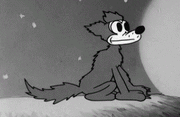
He appears in Ride Him, Bosko! in the opening scene
Crazy Crows
The Crazy Crows (named Jose and Manuel) are two Mexican crows in the Merrie Melodies and Looney Tunes films. They appeared twice in the series in the cartoons Two Crows From Tacos, and Crows Feat. Jose and Manuel also appear in the 1996 film Space Jam.
The Crusher
The Crusher is a brutish professional wrestler in 1951's Bunny Hugged (directed by Chuck Jones). He is voiced by John T. Smith. A similar character named The Champ appears in the 1948 cartoon Rabbit Punch. Crusher also appeared in a Tiny Toon Adventures episode featuring two songs by They Might Be Giants: Particle Man (as a wrestler) and Istanbul (Not Constantinople) (as a henchman).
Crusher also had a cameo role in Carrotblanca as a doorman, and appeared in an episode in The Sylvester and Tweety Mysteries. He also appeared in two episodes of Duck Dodgers, voiced by John DiMaggio. Crusher appeared on the web show "fast food" on looneytunes.com.
In the 2003 film, Looney Tunes Back in Action, The Crusher makes a cameo as one of the judges on DJ's stunt performance.
Crusher was a boss character in the Super NES video game Bugs Bunny Rabbit Rampage. Seen in the background are various Looney Tunes characters, and Pepe Le Pew is waving a pennant that reads "Le Crusher".
The Crusher appeared in The Looney Tunes Show episode "Jailbird and Jailbunny" as an inmate at the prison where Bugs and Daffy are incarcerated in. The Crusher next appeared in the episode "Fish and Visitors," as a wrestler on television. He also appeared in two Merrie Melodies segments "Blow My Stack" (as one of the characters at Clarence Cat's anger management group) and "Yellow Bird".
Curt and Pumpkinhead
Curt and Pumpkinhead are hillbilly brothers in that appear in the Merrie Melodies series of shorts. Curt has long, black beard, and Pumpkinhead has an orange beard. They are armed with a gun. They also wear a tall hat.
They debuted in Holiday For Drumsticks, against Daffy Duck and Tom Turkey. Their second and final appearance was in Hillbilly Hare, attempting to kill Bugs for no apparent reason.
D
Daffy Duck
- Main article: Daffy Duck
Daffy's Wife
Daffy Duck appears to have a wife in Wise Quacks and The Henpecked Duck.
Daffy's Son
Daffy Duck has a son in:Wise Quacks(as an egg) The Henpecked Duck(on-screen).
Demon Beast
The Demon Beast is a creature who's sole purpose is to haunt Beans in the short A Cartoonist's Nightmare, which so far is his only appearance to date.
Dicky
Dicky is a deceased bird who was mentioned in the short Puss n' Booty.
Doctor I.Q. Hi
Dr. I.Q. Hi is a scientist who works with Duck Dodgers.
- Main article: Dr. I.Q. Hi
Doctor Frankenbeans
Doctor Frankenbeans is a mad scientist who appears in Hair-Raising Hare and Water, Water Every Hare as an enemy of Bugs. He went unnamed in classic cartoons, and was given his name in the video game Looney Tunes: Acme Arsenal in which he was the main antagonist. He is the creator of Gossamer.[3]
In the Duck Dodgers episode "Enemy Yours," Doctor Frankenbeans appears as Dr. Woe (voiced by Maurice LaMarche) who is one of the Martian Commander X-2's enemies.
Also in the webtoon, Island of Dr. Moron he is known as "Dr. Moron" and gives life to a carrot which he uses (in addition to Gossamer) to destroy bugs.
Doctor Jekyll
Dr. Jekyll appeared in some Warner Bros. Looney Tunes and Merrie Melodies animated shorts including Hyde and Go Tweet, Hyde and Hare,and The Impatient Patient.
Dodsworth
Dodsworth is a fictional cat from the Merrie Melodies series loosely based on W.C. Fields. He is depicted as a larger lethargic cat with marking almost identical to Sylvester. He was very lazy and was proud of that fact. His attempts to coerce a white kitten to do his work for him ultimately backfire.
Donkey
Donkeys have appeared in many Looney Tunes shorts. A donkey first appeared in Falling Hare and also showed up in Robin Hood Daffy, where Daffy is seen riding one.
The Drunk Stork
The Drunk Stork delivers babies to the wrong families.
- Main article: The Drunk Stork
E
Egghead
- Main article: Egghead
Egghead, Jr.
Egghead, Jr. debuted in 1954's Little Boy Boo, and made two subsequent Looney Tunes appearances in 1955's Feather Dusted and 1960's Crockett-Doodle-Doo.
Egghead, Jr. is a large-headed and very intelligent baby chick and appeared in several shorts with bumptuous Foghorn Leghorn (also a character directed by McKimson and voiced by Blanc). The only child of Miss Prissy, a widow hen, Egghead, Jr. was bookish and never talked (though he mumbled when he counted playing hide-and-seek with Foghorn in Little Boy Boo). Foghorn would try to teach him to play games like baseball and cowboys and Indians, with the intent that he act more like a typical boy, but invariably resulting in bodily injury for Foghorn.
In 1991, Egghead Jr. appeared in the Tiny Toon Adventures episode "Hog-Wild Hamton"; he's Hamton's neighbor and he doesn't like being disturbed, so when a wild party takes place at Hamton's house and the guests refuse to keep the noise down, Egghead takes matters into his own hands. Egghead Jr. also makes a cameo in Star Warners.
Elmer Fudd
- Main article: Elmer Fudd
F
Fluffy
Fluffy is Piggy's girlfriend.
- Main article: Fluffy
Fly
A fly is an insect that is often used in Looney Tunes Characters to annoy others. A fly first appeared in Rhapsody Rabbit. Two separate flies appeared in Road Runner and Wile E. Coyote shorts. One can be seen in Red Riding Hoodwinked. Another was seen in The Looney Tunes Show's CGI Short, Silent But Deadly.
Fido
Casper Caveman's pet dinosaur(that applies traits of a dog) that appeared in Daffy Duck and the Dinosaur.
Foghorn Leghorn
- Main article: Foghorn Leghorn
Foxy
- Main article: Foxy
Fred Sheepdog
Fred Sheepdog is a sheepdog with black bangs, and has a resemblance to Sam Sheepdog. He is the co-worker to Sam and appears in Sheep Ahoy and Don't Give Up the Sheep. For reasons unknown, he is referred to as "Ralph" in the beginning of the cartoons, and "Fred" at the end. He was voiced by voice actor Mel Blanc.
Frisky Puppy
Frisky Puppy is a young puppy who loves to play. He appeared in three cartoons, opposite Claude Cat, all directed by Chuck Jones. Frisky often sneaks up on Claude when Claude is trying to get rid of him, making the cat jump to the ceiling. With his loud barks and yelps, and obsessed with scratching himself because of fleas, Frisky seems to cause a lot of trouble for Claude. Since the puppy's first appearance, Two's a Crowd (1950), where Frisky was a present for the mistress of the house, Claude was always trying to get rid of Frisky, since the fact if Claude does not get along with the puppy then the cat can go. And it seems from the start that Claude hated Frisky, possibly due to Frisky's hyper active self. The Claude/Frisky storyline continued from Terrier Stricken (1952) to No Barking (1954). All the shorts portray Frisky winning over Claude, with the exception for Two's A Crowd, where the puppy loses to Claude in the end.
G
Gabby Goat
- Main article: Gabby Goat
Gabby Goat is a goat who was created by Bob Clampett to be a sidekick for Porky Pig in the 1937 short Porky and Gabby, directed by Ub Iwerks, who briefly subcontracted to Leon Schlesinger Productions, producers of the Looney Tunes shorts. The cartoon focuses on the title characters' camping trip, which is foiled by car trouble. Storyboard artist Cal Howard supplies Gabby's voice.
Gabby looks like Porky with a beard, horns, and scowl. The goat's chief characteristics are his irritability and short temper, traits that make him a natural foil for the shy, easy-going Porky. The concept didn't play out as well as the animators would have liked, however; audiences felt that the goat's behavior was too offensive to be funny. Gabby only appeared in two more cartoons. The first was Porky's Badtime Story (Clampett's first cartoon as director), where roommates Porky and Gabby are almost fired from their jobs for sleeping in and showing up late. They vow to get to sleep early that night, but various problems keep them awake all night. The cartoon was later remade in 1944 as Tick Tock Tuckered, featuring Daffy Duck in Gabby's role as Porky's co-star.
The third and final appearance of the character was in Get Rich Quick Porky, where Porky and Gabby dig for oil. Both Porky's Badtime Story and Get Rich Quick Porky were produced in 1937.
Recently uncovered storyboards show that Gabby Goat was originally planned to appear in the 1938 short Porky's Party. However, that role was later filled by a penguin character with a similar personality.
Gee-Man
Gee-Man is Buddy's dog and helper. His only appearance to date was in the short Buddy the Gee Man.
George
George is a Sylvester-like pussycat who has appeared in Lighthouse Mouse and Cat-Tails For Two.
General Gracias
General Gracias is a mouse general who is friends with a fat mouse named El Supremeo. His only appearance to date was in A Message to Gracias.
General Robert E. Lee
General Robert E. Lee is a civil war general of the Confederate Army who is mentioned in the short Rebel Without Claws. Sylvester attempts to disguise himself as the general in order to intercept Tweety Bird and the message for the general.
Giovanni Jones
Giovanni Jones is an opera singer that debuted in Long-Haired Hare. He was singing "Largo al Factotum" from The Barber of Seville until Bugs playing his music at the same time disrupted Giovanni enough to confront Bugs and destroy his instruments. After the final attack, Bugs does various pranks upon Giovanni at his performance leading up to him disguising himself as Leopold Stokowski where he conducts Giovanni into holding a singular high G note until Giovanni can hardly endure the strain. His face turns different colors as he squirms and unravels his formal wear. Bugs leaves his glove hovering in the air and steps outside to order a pair of earmuffs which are delivered instantly after Bugs places the order in the mailbox. Bugs returns to the stage to find Giovanni has obeyed the glove and is still singing the high note but is now thrashing about on the floor banging his fists, his face still turning various colors. Finally, the top of the concert hall's shell shatters and tumbles down on top of Giovanni. For the encore, a roughed-up Giovanni appears out of the rubble to take a bow. Witnessing one last piece of the amphitheater balanced on a steel beam above Giovanni, Bugs again cues the singer to close out his performance with the high note so that the piece falls and crushes him off camera.
In The Looney Tunes Show episode "Customer Service," Giovanni Jones' design is used to portray the unnamed manager of Copy Place. He first appears where he temporarily suspends Tina Russo after she snaps at a rude customer. However, he later reinstates her because he himself could not cope with the foolishness that came with working Tina's desk and admits that he had no idea what it's like dealing with those people. Especially since the customer he was having problems with at the time was Yosemite Sam who wanted Copy Place to print his money.
Goopy Geer
Goopy Geer was the last attempt by animator Rudolf Ising to feature a recurring character in the Merrie Melodies series of films. Goopy is a tall, lanky humanoid dog with scruffy whiskers and long, expressive ears. In all of his animated appearances, Goopy is depicted as light colored, but in an early promotional drawing for his first cartoon, he had black fur. A month after Goopy Geer's first cartoon had been released, Walt Disney released a cartoon with a character named Dippy Dawg—renamed "Goofy" in 1934, and notably referred to as "G. G. Geef" in 1950s shorts—whose overall appearance was very similar to that of Goopy Geer. Due to the proximity of the two cartoons' releases, there is little chance that either character was intended to be a copy of the other. Instead, both characters may have been inspired by earlier Ising drawings shown to Walt Disney, as with the Foxy - Mickey Mouse similarity.
Like most other early sound-era cartoon characters, Ising's Goopy has little personality of his own. Instead, he sings and dances his way through a musical world in perfect syncopation. Ising only featured the character in three cartoons. In the first, Goopy Geer (April 16, 1932), he plays a popular pianist entertaining at a nightclub. In Ising's other two Goopy films, both in 1932, he cast the dog first as a hillbilly in Moonlight for Two (June 11, 1932), then as a court jester in The Queen Was in the Parlor (July 9, 1932). All of these cartoons also feature Goopy's unnamed girlfriend who debuted without her gangly consort in the earlier Merrie Melodie Freddy the Freshman (February 20, 1932). Goopy would make a cameo in the Bosko cartoon Bosko in Dutch (January 14, 1933), but after Ising left Warner Bros. that same year, Goopy and other recurring Merrie Melodies characters were retired, to be later replaced by such recurring characters as Sniffles the Mouse, Inki and the Mynah Bird, the Curious Puppies, and, on two occasions, Porky Pig (a character who was certainly more prevalent in the black and white Looney Tunes). Many of the Merrie Melodies nonetheless remained high-quality one-shot cartoons, until 1943, when the Looney Tunes and Merrie Melodies merged and became generic.
Goopy Geer had a small role in the 1990s animated series Tiny Toon Adventures. In the episode "Two-Tone Town" (September 28, 1992), Goopy, reprising his role as the happy-go-lucky pianist from his first cartoon, meets the series' stars when they visit the "black-and-white" part of town. His appearance in this cartoon is updated somewhat, and seems to be based on early promotional drawings where his fur is black, rather than his actual cartoon appearances.
Goofy Gophers
The Goofy Gophers are Mac and Tosh.
- Main article: The Goofy Gophers (characters)
Gossamer
Gossamer is the tennis-shoe monster.
- Main article: Gossamer
Granny
Granny is Tweety's owner.
- Main article: Granny
The Gremlin
A gremlin who likes to torment people/animals on planes or near planes. He has a laugh which sounds like:Ha Ha Ha Ha Hee Ha Ha!He first appeared in Falling Hare where he tormented bugs bunny. He later appeared in Russian Rhapsody on a plane with other gremlins that are caricatures of people at termite terrace. He made a cameo in Kitty Kornered as a disguise for one of the alien invaders.He last appeared in Space Jam (film) in the crowd scenes and made a cameo in one episode of The Looney Tunes Show at the pizzariba.
Grover Groundhog
Grover Groundhog is a character in the Merrie Melodies series of cartoons. His first and only appearance was in the short One Meat Brawl.
Gruesome Gorilla
- Main article: Gruesome Gorilla
Gustavo
Gustavo is Speedy Gonzales's posse member, friend, and cousin on some occasions. Gustavo is often seen alongside, a short, fat unnamed mouse. Gustavo, himself, is tall and has a snout-like nose. He bears a resemblance to Speedy's cousin Slowpoke Rodriguez. Gustavo usually plays a supporting role, and he never became a major star in the Looney Tunes and Merrie Melodies cartoons.
Gustavo appears in The Looney Tunes Show's Merrie Melodies segments "Queso Bandito" and "Pizzarriba".
H
Happy Rabbit
Happy Rabbit is the prototype that evolved into Bugs Bunny.
- Main article: Happy Rabbit
Ham and Ex
Ham and Ex are the dog nephews of Beans the Cat.
- Main article: Ham and Ex
Henery Hawk
Henery Hawk is the young chicken hawk who wants to eat Foghorn Leghorn.
- Main article: Henery Hawk
Hector the Bulldog
Hector the Bulldog is an animated cartoon character in the Warner Bros. Looney Tunes and Merrie Melodies series of cartoons. Hector is a muscle-bound bulldog with gray fur (except for A Street Cat Named Sylvester and Greedy For Tweety, where his fur is yellowish) and walks pigeon-toed. His face bears a perpetual scowl between two immense jowls. He wears a black collar with silver studs.
Hector first appeared in 1945's Peck Up Your Troubles, where he foils Sylvester's attempts to get a woodpecker. He also appeared in A Hare Grows in Manhattan, leading a street gang composed of dogs in a Friz Freleng-directed short; this is also the first short where the dog speaks & the only cartoon where the dog also took the antagonist role. After those shorts, Hector is a minor player in several Tweety and Sylvester cartoons directed by Freleng in 1948 and throughout the 1950s. His usual role is to protect Tweety from Sylvester, usually at Granny’s request. He typically does this through brute strength alone, but some cartoons have him outsmart the cat, such as 1954's Satan's Waitin', wherein Hector convinces Sylvester to use up his nine lives by pursuing Tweety through a series of extremely dangerous situations. In most of his appearances, the bulldog is nameless, though he is sometimes referred to as Spike. Hector never got his name till Fowl Weather (which was also his first speaking role). Freleng probably did not intend the character to be the same bulldog as the Spike he paired with Chester the Terrier in other cartoons. Fans frequently confuse Hector for Spike or Marc Antony, but by right, the three bulldogs are actually not the same.
Hector mostly featured in cartoons directed by Friz Freleng. However, it made cameo appearances in several cartoon shorts not directed by Friz Freleng (e.g. Mouse Wreckers; directed by Chuck Jones). His colorization and character design varies in shorts not directed by Friz Freleng; e.g. in Cheese Chasers (Jones, 1951), Hector's character design and fur color looked prototypical to Marc Antony.
Hector’s most prominent role was as a regular cast member in the animated series The Sylvester and Tweety Mysteries. In the cartoon, he plays Granny's loyal guardian. The show makes Hector's low intelligence his Achilles heel, as Sylvester is constantly outwitting him, and has him designed similar to Marc Antony. Originally played by Mel Blanc, Hector is currently voiced by Frank Welker.
Hector made a cameo in Tweety's High-Flying Adventure as the Brazilian counsellor. Here in the film, his character design has been reverted to this traditional classic-era design; and is seen dressed as a pirate. In the film, he was also voiced by Frank Welker.
Hector also appears in the video game Bugs Bunny & Taz: Time Busters where he guards one of the time gears in Granwich. He is a member of the studio audience in Sheep, Dog, 'n' Wolf.
Hiawatha
Hiawatha is an Indian boy supposedly modeled after Disney animator Ward Kimball in the Bugs Bunny cartoon Hiawatha's Rabbit Hunt. Hiawatha seemed to be very dumb and his voice was similar to Cecil Turtle or Beaky Buzzard.
Hippety Hopper
Hippety Hopper is a baby kangaroo that Sylvester mistakes for a giant mouse.
- Main article: Hippety Hopper
Mr. Hook
Mr. Hook is a sailor in cartoons made specifically for the U.S. Navy.
- Main article: Mr. Hook
Honey
Honey is Bosko's girlfriend.
- Main article: Honey
The Honey-Mousers
Ralph, Alice, and Ed are mice in the Warner Bros. Looney Tunes and Merrie Melodies series of animated shorts. They appear in the theatrical shorts The Honey-Mousers, Mice Follies, and Cheese It, the Cat!.
Horton the Elephant
Horton is the elephant from the Dr. Seuss book, Horton Hatches the Egg.
- Main article: Horton
Hubie and Bertie
- Main article: Hubie and Bertie
Hugo the Abominable Snowman
Hugo is a large, rather naive, and easily fooled Abominable Snowman who really likes bunny rabbits. He likes to name his pets "George" and tried on two occasions to make Bugs Bunny his pet. He seems to be an actual snowman, as he melted when exposed to the sun too long. His character is a takeoff on Lennie Small in Of Mice and Men. "George" refers to Lennie's friend George Milton in the novel (and movie).
Hugo appears in the episode The Abominable Snow Rabbit when Bugs and Daffy Duck run into him after accidentally traveling to the Himalaya Mountains.
In Spaced Out Bunny, it was shown that he was captured by Marvin the Martian and brought to Mars, where Marvin attempted to give Bugs to him as a pet.
In both appearances, he was voiced by Mel Blanc.
He later made brief appearances in Tiny Toons Adventures and Tweety's High Flying Adventure, this time voiced by Frank Welker. In the latter he had a different colour scheme here and was also shown to like cats as well as rabbits.
Hugo also appeared in Looney Tunes: Acme Arsenal.
I
Inki
Inki is a little African boy, who starred exclusively in the Merrie Melodies series of animated cartoons. Inki usually wears a simple loincloth, armband, legband, earrings, and a bone through his hair. He never speaks, is usually seen hunting jungle creatures, and is similar to the characteer "Little Hiawatha," from the Silly Symphonies cartoons. He usually co-stars alongside the Minah Bird, a droopy, sad faced black bird with an uncanny ability to overcome dangerous situations.
Inki filmography
- The Little Lion Hunter (1939)
- Inki and the Lion (1941)
- Inki and the Minah Bird (1943)
- Inki at the Circus (1947)
- Caveman Inki (1950)
Instant Martians
The Instant Martians are bird-like slaves of Marvin the Martian. They made their debut appearance in the animated short Hare-Way To The Stars. They have made few appearances since then, including The Bugs Bunny/Road Runner Movie.
They appear as enemies in the Area 52 stage of the Looney Tunes: Back in Action video game.
J
Jose and Manuel
Jose and Manuel are two Mexican cat brothers. Jose is tall and stupid, and Manuel is short and fiesty. Jose and Manuel are not to be confused with The Crazy Crows, who were named Hosea and Manuel. The two cats made their debut appearance in the Looney Tunes short Mexicali Shmoes, which introduced Speedy's cousin named Slowpoke Rodriguez.
Junior the Cat
Junior the Cat is a cat that appears in the Looney Tunes series of animated cartoons. Junior only appeared in the short Mouse-Placed Kitten. He was adopted by mouse parents named Clyde and Matilda. Clyde convinces Matilda that they cannot keep him. Unwillingly, they give up their son and bring him to a human home. Years later, they come to visit Junior, but Junior's owner wants him to kill the two mice. Junior tries to cover up for his parents, usually resulting in punishment.
Junior Rooster
Junior Rooster is a baby rooster, that appeared in the Looney Tunes series of cartoons. Junior was usually co-starred with Daffy Duck or Foghorn Leghorn. Junior Rooster appeared in two cartoons: The Up-Standing Sitter, with Daffy Duck and Broken Leghorn, with Foghorn Leghorn. Junior Rooster is not to be confused with Egghead, Jr..
K
K-9
Template:Infobox character K-9 is a green cartoon Martian dog in the Warner Brother's Looney Tunes series of animated shorts. He is closely associated with Marvin The Martian as K-9 is Marvin's pet dog and sidekick in some Looney Tunes productions. He has a few resemblances to Disney's Pluto.
K-9 premiered in the short Haredevil Hare, where he and his owner Marvin tried to thwart Bugs Bunny, who had stumbled on the pair's plans to destroy the Earth. He is given his first speaking role in this short, seeming quite unintelligent and gullible. That changes in later shorts where K-9 carries an air of superiority over his owner.
In recent Warner Bros. productions, K-9 only plays small cameo roles in video games and films, such as Sheep, Dog, 'n' Wolf, Space Jam, and the 2003 film Looney Tunes: Back in Action.
He has a starring role in two episodes of Duck Dodgers: "K-9 Quarry" and "K-9 Kaddy", in which he saves his master from dangers, and is berated by an oblivious Marvin, in a similar manner to the Porky and Sylvester shorts. The second of these episodes set him against Martian versions of the Goofy Gophers, in an obvious reference to Pluto's adversarial relationship with Chip N Dale.
Killer Mice
The Killer Mice are group of mice that pull deadly pranks on Porky Pig, in a strange hotel. Sylvester, trying to save his master, gets all the blame for the chaos, and is considered to be a scaredy cat. The Killer Mice have a resemblance to Hubie the Mouse. The Killer Mice first appear in the 1948 cartoon Scaredy Cat, and then in the 1954 cartoon Claws for Alarm.
L
Leo
Leo is a drunken human asking for approval from his peers at a party in the cartoon, Norman Normal.
Leo Lion
Leo Lion is an animated cartoon character in the Warner Bros. Looney Tunes and Merrie Melodies series of shorts. Leo made his debut in the Merrie Melodies short The Lyin' Mouse. Leo's second short The Lion's Busy, proved Leo to be even dumber than Beaky Buzzard. Leo's last two cartoons dealt with Bugs Bunny in Hold the Lion, Please, and Acrobatty Bunny.
The Leprechauns
The Leprechauns are two characters (one with a black beard an the other with an orange beard) that have appeared in the classic Looney Tunes short The Wearing of the Grin. In this short, Porky Pig does not believe in leprechauns, and the two leprechauns to decide to teach Porky a lesson by pulling pranks on him. They also have seen in the crowd scenes in Space Jam and appeared in Sylvester and Tweety mysteries.
Little Blabbermouse
Little Blabbermouse is an anthropomorphic mouse featured in the Warner Bros. Merrie Melodies shorts. His name is a pun on the term blabbermouth. Blabbermouse first appeared in the 1940 Merrie Melodies short Little Blabbermouse. In this short Little Blabbermouse goes on a tour with other mice around a Drug Store where the products live up to their names. The annoying non-stop talking mouse after much pestering the tour guide mouse and a close encounter with a cat gets a mouthful of Alum making him speak gibberish.
His second was the 1940 short Shop, Look and Listen, which has basically a similar plot except the scene is a grocery shop, they do not encounter a cat and Little Blabbermouse ends up gift wrapped. Little Blabbermouse has never been featured in any future short.
Little Kitty
A nervous cat who serves as a love interest for Beans. Voiced by Bernice Hansen.
Little Red Riding Hood
- Main article: Little Red Riding Hood
Little Beaver
Little Beaver is the boyfriend of a young Indian girl in his debut short, The Daffy Duckaroo. Daffy was almost kissed by him (Daffy was disguising himself as the Indian girl at the time).
M
Machine Gun Mike
Machine Gun Mike is a mobster. His only appearances were in Buddy the Gee Man and Porky Pig's Feat.
Magic Groundhog
A groundhog that was able to preform magic in "Get Rich Quick Porky" and made a cameo in "Now That Summer Is Gone".
Marc Antony and Pussyfoot
Marc Antony and Pussyfoot are a bulldog and a kitten.
- Main article: Marc Anthony and Pussyfoot
Marvin the Martian
- Main article: Marvin The Martian
Melissa Duck
- Main article: Melissa Duck
Merlin the Magic Mouse
Merlin the Magic Mouse was a nightclub magician (he usually preferred to be called a prestidigator, though he could never pronounce this correctly) who traveled around for work. Much of the humour of the character derived from the fact that, while he was often regarded as a cheap stage magician, he knew some very real and powerful magic tricks. His magic words were typically "Atascadero Escondido!" Merlin also has a sidekick, appropriately named Second Banana, which is a slang term for a magician's assistant.
Daws Butler provided the voice of Merlin and Second Banana in the first short, Merlin the Magic Mouse; Larry Storch performed the voices for the other four films.
Merlin is loosely based on W. C. Fields.
Michigan J. Frog
- Main article: Michigan J. Frog
Minah Bird
- Main article: Minah Bird
Miss Cud
Miss Cud is a cow and a School teacher in I Haven't Got a Hat. She is also an ice-skater in Alpine Antics. She made another appearance in Porky's Moving Day where her house is almost washed into the sea.
Monkey
Monkey is a character seen making cameos in various Looney Tunes shorts. His first appearance was in the short Hurdy-Gurdy Hare. He has also appeared in the shorts Canary Row, Room and Bird, and Devil May Hare. His appearance is mostly the same throughout his 4 appearances, except in Devil May Hare, where he is slightly redesigned.
N
Nasty Canasta
- Main article: Nasty Canasta
Nick 'O' Teen
Nick 'O' Teen is a fat man made of smoke who torments Porky Pig with his Tobbaco products in Wholly Smoke. He never appeared in any other cartoons or made any cameos.
Norman
Norman is the main protaginist of the short Norman Normal.
The Nutzy Crows
Two Nazi crows who try to get rid of Daffy Duck from their warfields in the short Daffy - The Commando. The leader crow is nameless, but his assistant (whom he always hits on the head with a huge mallet) is named Schultz. It is revealed that the leader actually hates Adolf Hitler and only works for him because he has to, and the leader has a mother in the telephone scene. The crows have never appeared in Looney Tunes/Merrie Melodies media since then, but the cartoon has fallen into public domain in recent years, and has appeared on many PD VHS/DVDs, a few with actual artwork of the crows. The cartoon also has VHS tapes (but no DVDs) where the cartoon is featured as the main cartoon, and a few of those tapes have the crows.
NOTE:The leader crow has been unofficially renamed Von Vulture.
O
Oliver Owl
Oliver Owl is a snooty owl who was first seen in I Haven't Got a Hat, as well as being a movie director in Hollywood Capers. His appearance is similar to "Owl Jolson" in I Love to Singa (1936). He finally appeared in re-designed version in Plane Dippy, where he and Little Kitty find a puppy, and they both teach the puppy to do tricks.
Oil Salesman
A salesman with a large mustache that tries to sell a piece of land supposedly full of oil to Porky and Gabby in Get Rich Quick Porky.
P
Pancho
Pancho is a Mexican Bandit. He is similar in appearance to Nasty Canasta. His only appearance was in Viva Buddy.
Penelope Pussycat
- Main article: Penelope Pussycat
Pepe Le Pew
- Main article: Pepé Le Pew
Pete Puma
Pete Puma debuted in the November 15, 1952 Rabbit's Kin, a Merrie Melodies animated short directed by Robert McKimson, from a story by Tedd Pierce. Animation was by Charles McKimson, Herman Cohen, Rod Scribner, and Phil De Lara. He is voiced by Stan Freberg.
Though Pete Puma made only two appearances, in Rabbit's Kin and in Pullet Surprise, he is often vividly remembered by cartoon fans, especially for his bizarre, inhaled, almost choking laugh, called "ihhhhh" (based on comedian Frank Fontaine's "Crazy Guggenheim" character). In Rabbit's Kin, Pete is chasing a young rabbit (named Buster Rabbit by some fans; and though he is called Buster at least once, in the cartoon Bugs repeatedly calls him 'Shorty'), who asks Bugs Bunny for help. Bugs is eager to oblige, and subjects Pete to some of his trademark pranks.
Pete Puma's voice was used in a Sylvester cartoon titled Mouse and Garden, in 1960.
More recently, he has made occasional appearances on Tiny Toon Adventures (as the Acme Looniversity janitor), episodes of The Sylvester and Tweety Mysteries, co-starred with Foghorn Leghorn in Pullet Surprise (voiced again by Freberg in all of these appearances), made a cameo appearance in the crowd scenes of Space Jam, Carrotblanca (as a waiter), Tweety's High-Flying Adventure, Bah, Humduck! A Looney Tunes Christmas, and is a supporting character in the Looney Tunes comic books.
Pete appears in The Looney Tunes Show episode "Reunion" voiced by John Kassir. He is shown to be a friend of Daffy Duck and Marvin the Martian. He also appears in "Devil Dog", as a zookeeper. Then in "To Bowl or Not to Bowl" as Daffy's teammates. Also in "Sunday Night Slice" where he works at Speedy's pizza restaurant, which was called Giradi's, and once again in "Working Duck" where he was watching the cart of EnormoCorp's muffin man.
Peter Bunny
Peter Bunny is a naughty, disobedient and irresponsible brown rabbit who wears a red shirt and instantly flouts his mother's instructions. He has several siblings in Country Boy (1935), where he plays hooky and raids a vegetable garden. He has a baby brother to take care of rescue from a weasel in My Green Fedora (1935).
Petunia Pig
Petunia Pig is Porky Pig's girlfriend.
- Main article: Petunia Pig
Polly
Polly is a common name given to a parrot. He first appeared in the short Buccaneer Bunny, being owned by the pirate Yosemite Sam.
Porky Pig
- Main article: Porky Pig
Porky Pig Juniors
The Porky Pig Juniors (also known as The Quintuplets) are a pair of pigs. They first appeared in the short Porky's Romance.
Pierre (Lumberjack)
Pierre is a Lumberjack and Bosko's Enemy. His only appearance to date was in Bosko the Lumberjack.
Piggy
Piggy first appeared as a fat, black pig who wears a pair of shorts with buttons on the front. His coloration and dress are identical to those of the Walt Disney character Mickey Mouse before the advent of color film. John Kenworthy argues that, considering the fact that some sketches of mice which Hugh Harman had drawn in 1925 were the inspiration for the creation of Mickey Mouse, Harman and Ising never intended to copy Disney.[4]
Piggy's name came from one of two brothers who were childhood classmates of Freleng's, nicknamed "Porky" and "Piggy".[5]
Animator Rudolf Ising introduced Piggy as a second character after Foxy to star in the Merrie Melodies series Ising was directing for producer Leon Schlesinger. Nonetheless, Ising had only made two Piggy shorts in 1931 before he went on to create Goopy Geer. The animators who took over the Merrie Melodies cartoons dropped the Piggy character (as well as his girlfriend Fluffy) and turned the series into a string of one-shots.
Despite their clichéd lead character, Ising's two Piggy shorts are well received by some critics. The first is the 1931 short You Don't Know What You're Doin'!. Here, Piggy visits a surreal night club where he heckles and plays with the club's jazz band. This was followed by Hittin' the Trail for Hallelujah Land, also in 1931. Here, Piggy plays a steamboat captain who must rescue a drowning Uncle Tom. Due to its stereotypical portrayal of the Uncle Tom character, the cartoon is included among the so-called "Censored 11", Looney Tunes and Merrie Melodies shorts that are withheld from circulation due to their heavy use of ethnic stereotypes.
In 1936, animator Friz Freleng redesigned Piggy for colour film. Piggy was given lighter, more Caucasian-like colour with distinguishing birthmarks. The redesigned character appeared as a gluttonous child in a large family of pigs in At Your Service Madame (which gives his full name as Piggy Hamhock),[6] where he leads his fellow siblings in foiling a bum's attempt to rob their mother. A year later he starred in Pigs Is Pigs in which his gluttony takes center stage.[6] This would be his final appearance. After that he was discarded with his character traits transferred for a time to Porky Pig.
Pincus Pig
Pincus Pig is Porky's uncle. He gave Porky a "genuine Oriental Silkworm" in the cartoon Porky's Party.
Pinky Pig
Pinky Pig is Porky Pig's nephew.
- Main article: Pinky Pig
Playboy Penguin
Playboy Penguin is a character in the animated cartoon Looney Tunes, created by Chuck Jones in the late 1940s and early 1950s. He debuted in 1949's Frigid Hare and he re-appeared in 8 Ball Bunny.
Playboy Penguin is a mute skating baby penguin that seeks Bugs Bunny for help. From his debut episode, an Eskimo tries to catch him until the little penguin found Bugs Bunny and wants him to help avoid the Eskimo hunter. Then, in his second episode with Bugs, the penguin either wants to go home in Antarctica or go to Hoboken to perform in the show.
Playboy Penguin also appears on The Sylvester and Tweety Mysteries and Space Jam. He also makes a cameo in the DS game Duck Amuck.
Filmography
- Frigid Hare (October 8, 1949)
- 8-Ball Bunny (1950)
- Space Jam (1996)-appears as auditor
- Bah, Humduck! A Looney Tunes Christmas (2006)-appears as customer
Miss Prissy
Miss Prissy or Prissy is typically described as an old spinster hen, thinner than the other hens in the chicken coop, wearing a blue bonnet and wire-rimmed glasses. The other hens describe her as "old square britches".
The premise of her cartoons are centered around the fact that the other hens are ridiculing Prissy. Her first appearance was in the 1950 short An Egg Scramble, the only cartoon featuring her and Porky Pig, in which the other hens are making fun of the fact that she cannot lay an egg (because she think it's embarrassing). Her next appearances are centered around Foghorn Leghorn. In Lovelorn Leghorn (1951), she is set on finding a husband and in Of Rice and Hen (1953) she is looking to have children. However, in Little Boy Boo (1954) she is depicted as a widow with a child Egghead Jr. and with a much more extensive vocabulary in long sounding words than her trademark "yeeesss". A Broken Leghorn (1959) and Strangled Eggs (1961), featuring Henery Hawk. In these shorts, it is usually Foghorn who is pursuing Prissy for his own selfish needs.[7]
Miss Prissy also appeared in The Looney Tunes Show episode "The Foghorn Leghorn Story" voiced by Grey DeLisle. She played Mama Leghorn in Foghorn Leghorn's movie called "The Foghorn Leghorn Story."
Private Snafu
- Main article: Private Snafu
R
Ralph Phillips
Ralph Phillips is an imaginative boy who likes to daydream about all kinds of things he sees around him. For example, in From A to Z-Z-Z-Z, Ralph, while attending school, daydreams about flying in the air like a bird, fighting off mocking numbers on a blackboard and Indians (this scene was later edited because of some Native American stereotypes and some violence), dispatching a dangerous saber-tooth tiger shark, and finally punching out a huge opponent in the boxing ring and leaving the school for the day as Douglas MacArthur. From A to Z-Z-Z-Z was nominated for an Academy Award.
Ralph appeared in a further Looney Tunes episode, Boyhood Daze, where he was sent up to his room for breaking a window with a baseball, wherein he indulged in similar daydreaming, and in the theatrically diverted TV pilot Adventures of the Road-Runner. In more recent years he has figured in issues of the DC Comics Looney Tunes comic book as well.
A more mature Ralph Phillips was also featured as an Army recruit in two cartoons produced specifically as military recruitment promotions, 90 Day Wondering and Drafty, Isn't It?, both directed by Jones.
Ralph Phillips was voiced by child actor Dick Beals (who would later be known for playing young boys in future projects due to a glandular problem). The older version was voiced by Warner Bros.' regular voice actor Mel Blanc, in 90 Day Wondering, and by Daws Butler, in Drafty, Isn't It?.
Ralph has a cameo as an unseen character in the Chuck Jones-directed animated adaption of The Phantom Tollbooth. He calls the protagonist Milo near the start of the film (where he speaks with the voice of June Foray and is referred to by name), and briefly speaks with Milo again just before the film ends.
Ralph Wolf
- Main article: Ralph Wolf and Sam Sheepdog
Red Hot Ryder
Red Hot Ryder appeared in Buckaroo Bugs. He is a dimwitted cowboy, assigned to bounty hunt and dispose of the Masked Marauder (who is Bugs Bunny). He somewhat resembles Yosemite Sam, minus the beard and mustache.
His voice is provided by Mel Blanc, sounding like Cecil Turtle or The Flintstones' Barney Rubble.
Road Runner
- Main article: Wile E. Coyote and The Road Runner
Robot Rabbit
The Robot Rabbit is a machine made by the ACME Pest Co. and it's purpose is to capture rabbits for it's master. It's only appearance is in the short, Robot Rabbit.
Robot Pilot
The Robot Pilot is a robot that is built to fly a plane. His only appearance is in Hare Lift where he activated the parachute.
Rocky and Mugsy
- Main article: Rocky and Mugsy
Rover
Rover is Elmer Fudd's dog in the Looney Tunes and Merrie Melodies series. Several shorts feature him, as a minor role. Of course, the joke is that Elmer can't pronounce the name right, calling him "Wover." Rover is a usually a loyal dog, but can become aggressive to Elmer when he feels threatened. Rover shares a close resemblance to Barnyard Dawg in Robert McKimson-directed shorts, as his design varies in shorts directed by different directors. Rover first appeared in the black and white short Porky's Pooch, originally paired with Porky Pig. His next two appearance were in To Duck or Not to Duck and Hare Remover, with Elmer Fudd and this time with an entirely brown color scheme. His final two cartoons with Elmer Fudd developed his permanent color scheme in A Mutt in A Rut and Don't Axe Me.
Roxy
Roxy is Foxy's girlfriend.
- Main article: Roxy
S
Sam Cat
Sam Cat is an orange cat that claims to be friends with Sylvester. But when it comes to food, they are deadly rivals. They fight over a mouse in Mouse and Garden and fight over Tweety in Trick or Tweet. His other appearances are The Spy Swatter and Merlin the Magic Mouse.
Sam Sheepdog
- Main article: Ralph Wolf and Sam Sheepdog
Colonel Shuffle
- Main article: Colonel Shuffle
Shep
A glory stealing an unscrupulous dog that appeared in "Fresh Airedale", about a dog that keeps taking credit for the good deeds of a cat and placing blame on the cat.
Sloppy Moe
Sloppy Moe is a hillbilly who appeared in Injun Trouble and its remake Wagon Heels. He would go around quoting "I know something I won't tell, I won't tell, I won't tell!" to the tune of London Bridge is Falling Down. When Porky Pig is cornered by Injun Joe, Sloppy Moe reveals that Injun Joe is ticklish and proceeds to tickle Injun Joe with his beard and hands enough to cause Injun Joe to fall off the cliff enough to stretch the entire United States enough to cover the entire area. With the United States colonized, Sloppy Moe then tickles Porky. Sloppy Moe was voiced by Mel Blanc.
In the Tiny Toon Adventures episode "New Character Day," a cartoon called "The Return of Pluck Twacy" has Sloppy Moe parodied as a criminal named "Ticklepuss" (voiced by Frank Welker). When Ticklepuss attacks Pluck Twacy and states that ducks are ticklish in the ears, Pluck Twacy states that ducks don't have ears. Ticklepuss places fake ears on Pluck Twacy and proceeds to tickle them. Remembering what Duck Twacy would to at a time like this, Pluck Twacy subjects himself to pain enough to drive Ticklepuss away.
Sniffles and Mary Jane
- Main article: Sniffles
Slowpoke Rodriguez
Slowpoke Rodríguez ("Lento Rodríguez" in Spanish, though some more recent translations call him "Tranquilino") is described as "the slowest mouse in all Mexico" from the country side of Mexico, and is a cousin to Speedy Gonzales, who is known as the fastest. However, he mentions to his cousin that while he may be slow in the feet, which he is best known for, he's not slow in "la cabeza" (the head). He speaks in a monotone voice and seems to never be surprised by anything. While he is the slowest mouse in all of Mexico he has been shown to have certain other (more extreme) methods of protecting himself.
Slowpoke only appeared in two cartoons alongside his cousin. The first, Mexicali Shmoes (1959), ends with two lazy cats, Jose and Manuel, the former learning the hard way that Slowpoke carries a gun (though the gun bit has been edited out of this cartoon in recent years). The second, Mexican Boarders (1962), revolves around Speedy trying to protect Slowpoke from Sylvester the Cat, but in the end, Slowpoke demonstrates his ability to hypnotize Sylvester into becoming his slave. This short (which was later edited into Bugs Bunny's 3rd Movie: 1001 Rabbit Tales) contains a possible allusion to a marijuana habit when Slowpoke sings La Cucaracha. Despite his few appearances, "Lento Rodríguez" is an immensely popular character in Latin America.
Slowpoke also appears alongside Speedy in a commercial for Virgin Media's broadband service in the UK.
Squirrel
The Squirrel is a type of chimpmunk that usually lives in the trees. A squirrel first appeared in The Tree's Knees. Another one later appeared in A Corny Concerto.
Speedy Gonzales
Speedy Gonzales is the fastest mouse in all Mexico.
- Main article: Speedy Gonzales
Spike the Bulldog and Chester the Terrier
Spike the Bulldog and Chester the Terrier are animated cartoon characters in the Warner Bros. Looney Tunes and Merrie Melodies series of cartoons. Spike is a burly, gray bulldog who wears a red sweater, a brown bowler hat, and a perpetual scowl. Chester is just the opposite, a small and jumpy terrier with yellow fur and brown, perky ears.
The characters starred in only two shorts, both directed by animator Friz Freleng. The first of these films was 1952's Tree for Two. In it, Chester tells his idol Spike that he knows of a cat that they can beat up. The cat is Freleng's own Sylvester, but every time Spike thinks he has the cat cornered, a runaway zoo black panther appears in Sylvester's place, thrashing the dog instead. Spike gets easily sent into a panic when he thinks Sylvester is going to kill him and runs away to hide, giving Sylvester the chance to get revenge. When Chester decides to have a go of it, however, Sylvester finds himself at the little dog's mercy. By the cartoon's end, Spike and Chester have switched roles; Spike is the fawning sycophant, and Chester the smug prizefighter.
The characters' second outing came in the 1954 film Dr. Jerkyl's Hyde. Spike (here called "Alfie" and with an English accent) is once again after Sylvester, only this time it is Sylvester himself who pummels the poor pooch, thanks to a potion that transforms him into a feline monster. Chester, of course, never sees this transformed Sylvester, thinking his buddy is being beaten by the tiny tomcat. The final loss of face for Alfie is his being thrashed by a fly that has also been affected by the potion, as it occurs in front of Chester's eyes.
In both of these cartoons, Spike is performed by voice actor Mel Blanc, and Chester is performed by Stan Freberg. In modern Warner Bros. media, Spike's voice is provided by Joe Alaskey,
Fans frequently confuse Spike for Hector in a red sweater but by right they are actually not the same.
The pair also appear in the 1996 film Space Jam as a pair of paramedics during the basketball game.
Another bulldog character appeared in other cartoons with Sylvester and Tweety, but this character is not Spike; he is officially known as Hector the Bulldog. Several Tom and Jerry cartoons produced by MGM also featured a character named Spike the Bulldog (and his son, Tyke), Coincidentally, WB now owns the Tom & Jerry cartoons as well (through Turner Entertainment). This is another character, unrelated to the Spike used by Freleng. Also, several Tex Avery-directed cartoons produced by MGM also featured a different-versioned character named Spike the Bulldog, which also appeared in the Droopy series of cartoons. Again it is also unrelated to the Spike used by Freleng, too.
Swenson
Swenson is a local town baker who debuted in the cartoon Busy Bakers.
Sylvester
- Main article: Sylvester
Sylvester Junior
Sylvester Junior is Sylvester's son.
- Main article: Sylvester Junior
T
Tasmanian Devil
- Main article: Tasmanian Devil
Tasmanian She-Devil
- Main article: Tasmanian She-Devil
The Hep Cat
This unnamed feline is a black-and-white cat who looks prototypical to Sylvester The Cat. He first appeared in black-and-white in the 1941 Porky Pig short Notes to You, directed by Friz Freleng. He appeared for the first time in color in Double Chaser (1942). He would later reappear in shorts such as The Hep Cat (1942); the first color Looney Tunes short, The Fifth-Column Mouse(1943) as a Hitler-like antagonistic cat, and lastly in Birdy and the Beast (1944), as Tweety's antagonist. After Birdy And The Beast, the character is eventually discarded and then redeveloped as the official feline character Sylvester.
The cat appeared in a total of 5 shorts; three directed by Friz Freleng, and two directed by Bob Clampett.
The Three Bears
The Three Bears are a family that consists of Papa Bear (sometimes called Henry), Mama Bear, and Junior Bear (sometimes spelled Junyer or Joonyer).
Animator Chuck Jones introduced the trio in the 1944 cartoon Bugs Bunny and the Three Bears. In the short, Papa Bear tries to feed his starving family by having them act out their roles in the traditional fairy tale from which they derive their name. Unfortunately for them, when they were out of porridge, Mama substitutes carrot soup for it, and the "Goldilocks" they lure turns out to be none other than Bugs Bunny. For the bulk of the series, Voice actors Billy Bletcher, Bea Benaderet, and Stan Freberg played Papa, Mama, and Junior, respectively. However, in the initial entry Mel Blanc played Papa, and Kent Rogers played Junior (Freberg assuming the role after Rogers's death in World War II). After the classic shorts, Will Ryan and Joe Alaskey play Henry and Mama while Junior is still voiced by Stan Freberg.
Jones' bears as introduced in the short are perhaps the first film satire of the American nuclear family and how its traditional roles were coming under increasing scrutiny in the 1940s. Papa is a loud-mouthed, short tempered and often abusive shrimp, while Junior is an oversized, muscular, buffoon. The two are constantly at each other (usually Junior at Papa's wrath), leaving Mama Bear as the innocent (and deadpan) middle-bear, although she often resorts to thwacking one of them with a rolled-up newspaper to keep the peace. As Jones himself was never shy to point out, this cartoon and others in the series anticipate the failings and foibles that would later make the sitcom All in the Family such a success.
Jones brought back the Bears for his 1948 cartoon What's Brewin', Bruin?, this time sans Bugs. Here, alpha-male Papa Bear decides, after losing a card game, that it's time for the Bears to hibernate. Like any good family should, Mama Bear and Junior Bear obey, but Mama's snoring and Junior's creaky cradle keep Papa from getting the sleep he himself advocated. Junior's voice is here supplied by Stan Freberg, who would retain the role for all future Three Bears cartoons, including The Bee-Deviled Bruin and Bear Feat, released on Looney Tunes Assorted Nuts, both in 1949. Mama Bear made a cameo appearance in the 1950 Daffy Duck short The Scarlet Pumpernickel.
1951's A Bear for Punishment, the last film in the series, is often considered the funniest, and it is perhaps the most satirical. This time, it's Father's Day, and Mama and Junior's well-intended gifts do nothing but dishonor the perturbed Papa. Jones later stated that many of the scenarios in the short were derived from his own experiences.
Jones retired the Three Bears in 1951. The influence of the series would linger, however, as other studios copied or altered the idea. Aside from Norman Lear's aforementioned All in the Family, Famous Studios repeated Jones family scenario in their Baby Huey series of cartoons. The Bears' cartoons most significant impact was perhaps on Jones himself, as these films (along with the Hubie and Bertie and Charlie Dog shorts) represent some of Jones's earliest work.
Mama Bear of the Three Bears can be briefly spotted in a brief headshot during the final scene of the 1988 film Who Framed Roger Rabbit.
In the early 1990s, the Three Bears were brought back and featured several times in the TV series Tiny Toon Adventures. Most famously, they appeared in an updated "90's version" of the classic Three Bears fairy tale (with Elmyra playing the part of Goldilocks), which parodied suburbia and the mass commercialism prevalent in American society. In the episode, "Prom-ise Her Anything", Mama Bear is seen as a lunch lady. Papa Bear also appeared as the vendor in "Garage Sale of the Century" in Animaniacs.
In Looney Tunes: Back In Action, the Bears are tourists in Paris. They run into DJ Drake (Brendan Fraser), whose trousers have rocketed off into the air leaving him in his underwear. DJ steals Papa Bear's trousers so he can save Jenna Elfman's character from a villain.
Tina Russo
Tina Russo is a female duck that appears in the 2011 Cartoon Network series The Looney Tunes Show. She is Daffy Duck's girlfriend. She made her debut appearance in season one, volume three, episode twelve of the series in "Double Date." Daffy "wins" a romantic dinner for two and asks Tina, who is working at the Copy Place. Surprisingly, the two find that they are perfect for each other and have a lot in common.
Tina has appeared in many episodes since then, in "Bugs and Daffy Get a Job," on a date with Daffy, "That's My Baby," taking care of her sister's kid, "Beauty School," becoming a hairdresser, "The Shelf," giving Porky a pep talk and helping Bugs with remodeling advice, and "Muh-Muh-Muh-Murder," at Daffy's surprise party.
In "Daffy Duck Esquire," Bugs and Daffy meet Tina's father Frank as Daffy passes himself off as a lawyer to impress him.
Tom Turk
Tom Turk is a turkey who appears and co-stars with Daffy in the animated shorts Tom Turk and Daffy (1944) and Holiday For Drumsticks (1949). In "Tom Turk and Daffy," Tom Turk starts as a target for a thanksgiving dinner and by the end it is Daffy who is doomed to be the dinner, but manages to cliff hang that possible fate.
Tommy Turtle
Tommy Turtle is character from the Merrie Melodies series of animated shorts. He was a member of the class in I Haven't Got A Hat and a referee in Alpine Antics.
Tweety
- Main article: Tweety
Tweety's Owner
Tweety had several different owners in the cartoons before ending up with Granny. They mostly were designed to be kept around to beat up Sylvester as punishment for attempting to eat Tweety. She appeared in Tweetie Pie and All a Bir-r-r-d.
Tweety's Master
Tweety's Master is a giant that owned Tweety, and an enemy of Sylvester. His only appearance to date was in Tweety and the Beanstalk.
Two Curious Puppies
- Main article: The Two Curious Puppies
W
The Weasel
The Weasel is a recurring character in Foghorn Leghorn cartoons. He often attempts to steal eggs but Leghorn and the Barnyard Dawg foil his plans. He was voiced by Mel Blanc and Frank Welker. His only three appearances were Plop Goes the Weasel in 1952, Weasel Stop in 1956, and Weasel While You Work in 1958.
Wile E. Coyote
- Main article: Wile E. Coyote and The Road Runner
Willoughby the Dog
- Main article: Willoughby
Witch Hazel
- Main article: Witch Hazel
Unnamed Weeman
The Weemen appear in the short Señorella and the Glass Huarache.
Y
Yosemite Sam
- Main article: Yosemite Sam
Yoyo Dodo
- Main article: Yoyo Dodo
References
- ↑ The Bird Came C.O.D. at imdb.com
- ↑ Conrad Cat at TV.com
- ↑ Looney Tunes: Acme Arsenal instruction booklet; Gossamer's profile.
- ↑ Kenworthy, John The Hand Behind the Mouse, Disney Editions: New York, 2001. p. 54
- ↑ Beck, Jerry. Audio commentary for "I Haven't Got a Hat" on the Warner Bros. DVD set Looney Tunes Golden Collection, Volume 3. (2005) citing Freleng's autobiography.
- ↑ 6.0 6.1 Looney Tunes and Merrie Melodies: A Complete Illustrated Guide to the Warner Bros. Cartoons. Henry Holt and Company. ISBN 0-8050-0894-2
- ↑ Miss Prissy the widow chickeness who was in love with Foghorn. Petcaretips.net. Retrieved on 2011-08-30.



